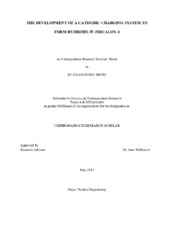| dc.creator | Brito, Ryan | |
| dc.date.accessioned | 2015-09-03T15:24:35Z | |
| dc.date.available | 2015-09-03T15:24:35Z | |
| dc.date.created | 2013-05 | |
| dc.date.issued | 2013-02-01 | |
| dc.date.submitted | May 2013 | |
| dc.identifier.uri | https://hdl.handle.net/1969.1/154882 | |
| dc.description.abstract | This project investigates several methods of electrochemical insertion of hydrogen into Zircaloy nuclear fuel cladding. These systems are being assembled at Texas A & M to form zirconium hydride in cladding to model crack propagation during storage in dry cask, determining the protective lifetime of the cladding. Hydride concentration profiles found in cladding before entering dry cask storage could not be duplicated using the system originally built in this project. Several modifications were made, including the introduction of a nitrogen bubbler, application of lead cathodes, and the refinement of set-up, and an additional hydrobisulfate ion bath system was built. Future work will further utilize these systems to attempt to replicate hydride profiles in spent fuel and apply samples in the development of a model to predict crack propagation through fuel cladding. | en |
| dc.format.mimetype | application/pdf | |
| dc.subject | Zircaloy | en |
| dc.subject | hydrogen | en |
| dc.subject | electrochemical | en |
| dc.subject | nuclear cladding, dry cask storage | en |
| dc.title | The Development of a Cathodic Charging System to Form Hydrides in Zircaloy-4 | en |
| dc.type | Thesis | en |
| thesis.degree.department | Nuclear Engineering | en |
| thesis.degree.discipline | Nuclear Engineering | en |
| thesis.degree.grantor | Honors and Undergraduate Research | en |
| dc.contributor.committeeMember | McDeavitt, Sean | |
| dc.type.material | text | en |
| dc.date.updated | 2015-09-03T15:24:35Z | |


